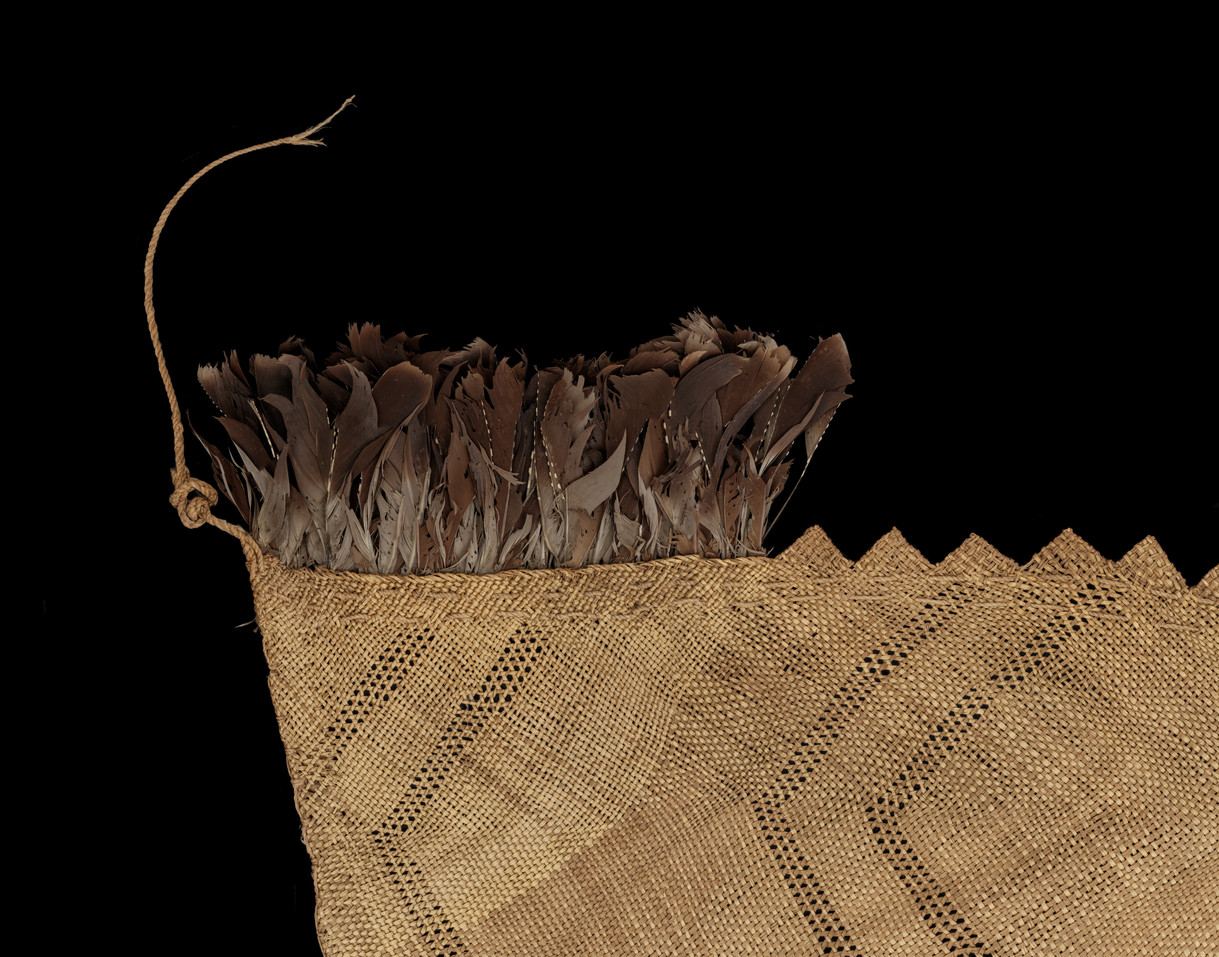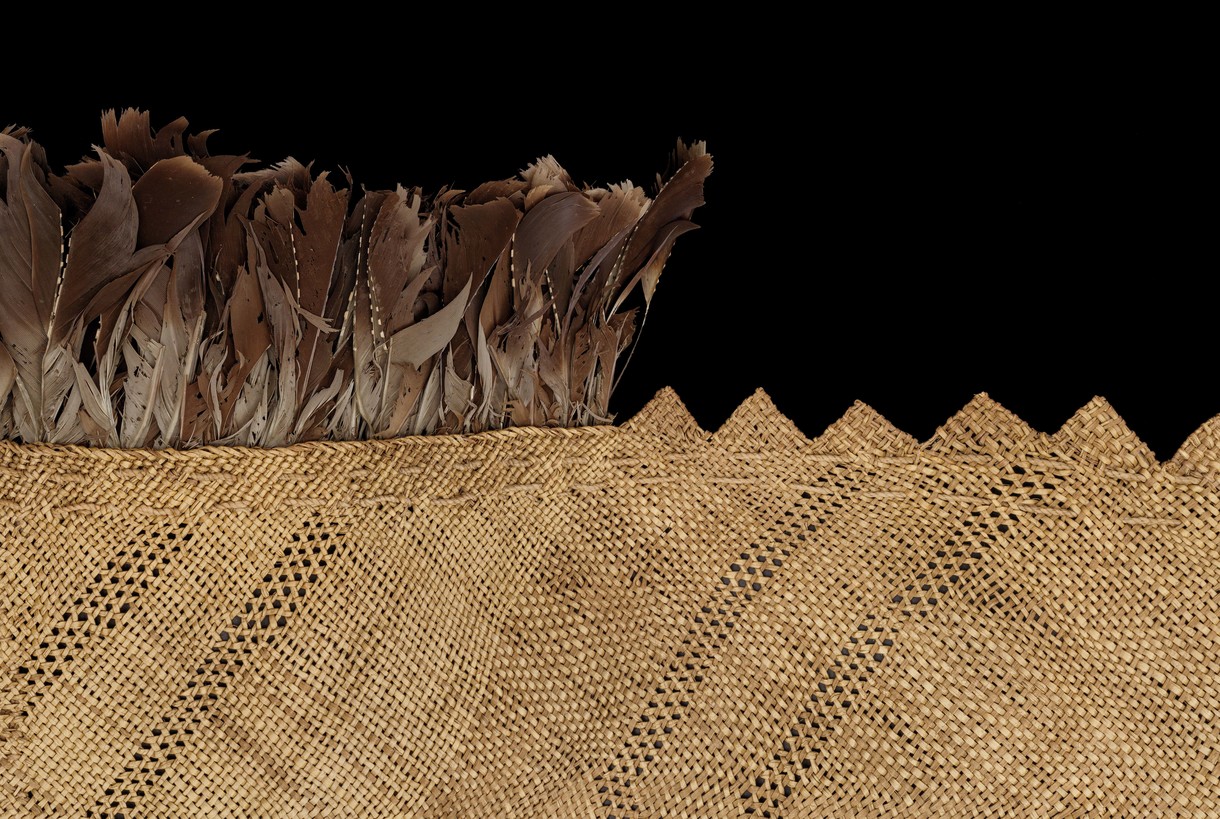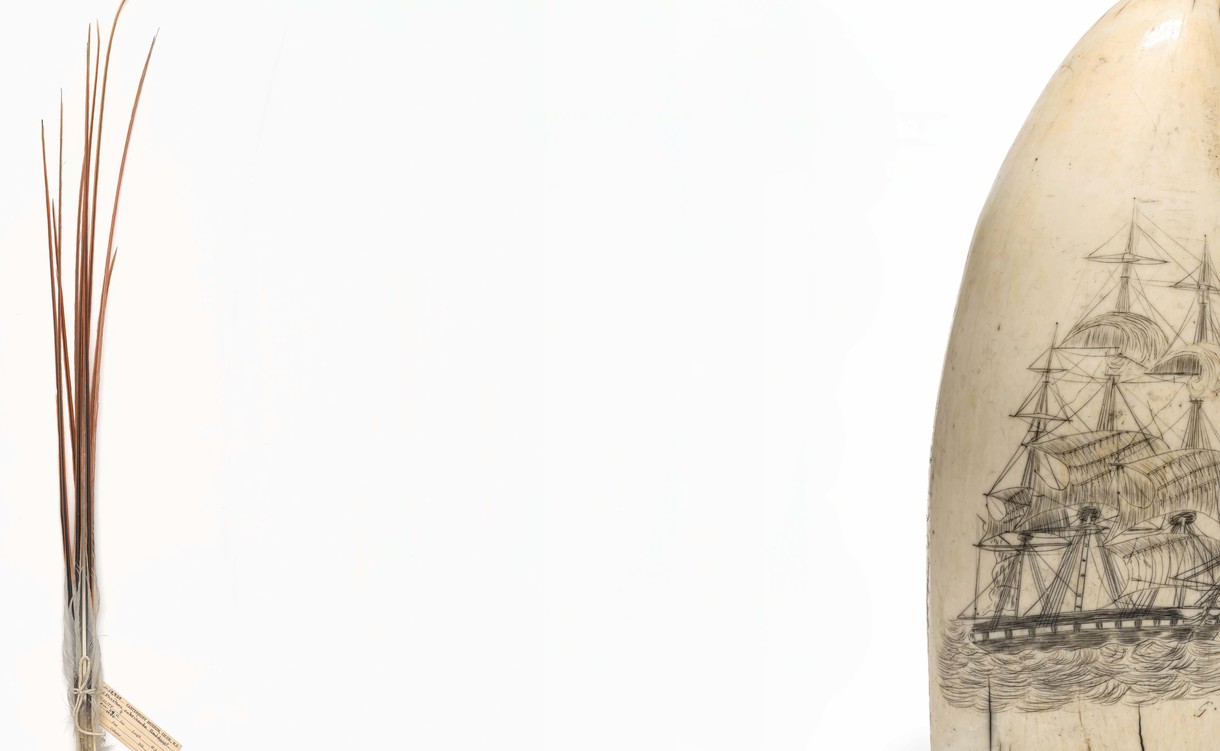The More we Learn, The Less We Know
Understanding Te Rā
![Makers unknown Te Rā [the sail] (detail) c. 1770–1800. Harakeke, kererū, kāhu and kākā feathers, dog skin. On loan from the Trustees of the British Museum. © The Whakaarahia anō te rā kaihau Te Rā Project. Photo: Cultural Heritage Imaging](/media/cache/ef/e8/efe80dea3b1692a781a7cd1bcc6e3573.jpg)
Makers unknown Te Rā [the sail] (detail) c. 1770–1800. Harakeke, kererū, kāhu and kākā feathers, dog skin. On loan from the Trustees of the British Museum. © The Whakaarahia anō te rā kaihau Te Rā Project. Photo: Cultural Heritage Imaging
In July 2023 Christchurch Art Gallery Te Puna o Waiwhetū welcomes Te Rā. This taonga from the collection of the British Museum will be on public display in Ōtautahi for three months before travelling to Auckland Museum and then returning to London. The homecoming of this taonga is a deeply significant moment. In March, pouarataki curator Māori Chloe Cull, was joined by Ranui Ngarimu ONZM (Ngāi Tahu, Kāti Māmoe, Ngāti Mutunga) and Dr Catherine Smith, two members of the research group that has led the project to bring Te Rā to Aotearoa, to talk about what this homecoming means to them.
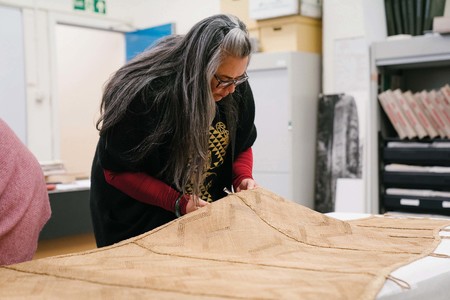
Donna Campbell inspecting Te Rā at the British Museum. © The Whakaarahia anō te rā kaihau Te Rā Project. Photo: Adam Rowley
Ranui Ngarimu: Te Rā is a sail. It’s the only known Māori sail from post early contact. It’s unique in that it is the only one from that time still in existence. And it’s in the British Museum, where it has been for approximately 200 years.
Chloe Cull: Catherine, how did your involvement with Te Rā come to be?
Catherine Smith: It came out of meeting Ranui. I was doing my PhD research on early Māori textiles and I got in touch with Ranui to see if she would like to work with me. Beginning at Canterbury Museum, we travelled around the world together studying kākahu held in different collections. We went to Sweden and we went to Ireland – all sorts of places. We got used to sitting on buses and drinking cups of tea and doing all of those travelling things!
We were having a cup of tea on the last day of a visit to the British Museum and one of the collection managers made the mistake of asking Ranui if there was anything else she’d like to see! She said, “I’d like to see Te Rā”. And to our great surprise, then and there they took us to see her. As we were sitting looking at her, Ranui looked over at the table at me and said, “We’ve got to bring her home”.
So we approached Dr Donna Campbell, who was the first Māori person I ever worked with in a museum twenty-two years ago when I first came to New Zealand. Ranui has worked with her for much longer than that. Together we applied for a Marsden Grant from Te Apārangi Royal Society of New Zealand to do the work, and we were really lucky to be successful. That’s how we started off on this journey together, Donna, Ranui, and I.
We never actually dreamed that this day would come, that Te Rā would physically come to Aotearoa New Zealand again. Our kaupapa was to find out what the plant materials were, to understand the weaving, to record it, to document, to look at the provenance, so that all of the different kinds of information contained in her could be accessible again to the people of Aotearoa.
![Makers unknown Te Rā [the sail] (detail) c. 1770–1800. Harakeke, kererū, kāhu and kākā feathers, dog skin. On loan from the Trustees of the British Museum. © The Whakaarahia anō te rā kaihau Te Rā Project. Photo: Cultural Heritage Imaging](/media/cache/23/0b/230bd1bf4dfdb321e862b805a4a9f0de.jpg)
Makers unknown Te Rā [the sail] (detail) c. 1770–1800. Harakeke, kererū, kāhu and kākā feathers, dog skin. On loan from the Trustees of the British Museum. © The Whakaarahia anō te rā kaihau Te Rā Project. Photo: Cultural Heritage Imaging
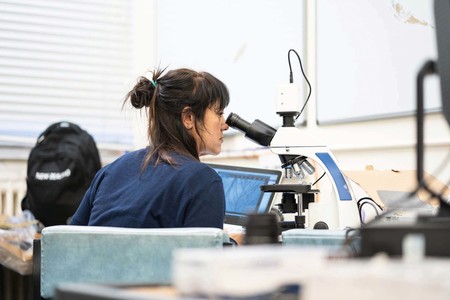
Hokimate Harwood at the British Museum. © The Whakaarahia anō te rā kaihau Te Rā Project. Photo: Adam Rowley
CC: Kia ora Catherine. Whaea Ranui, what was it like when you first saw Te Rā?
RN: It just took my breath away. We didn’t see the whole thing – we only saw part of it because they didn’t have enough room to unroll it all. The first thing I did was a karanga and then I had a little tangi (well, a big one actually). Then I just spent the rest of the time looking – looking at how it was made, how it was constructed. And it just raised so many questions. I said to Catherine, “What is it doing here, why is it here? We’ve got to do something about this, we’ve got to bring this information home.”
Thankfully our grant application was accepted and we were able to go and visit Te Rā again. Catherine worked her magic and acquired little bits and pieces to test, which was not easy to do, but in the end the relationship that we built up with the British Museum allowed her to take samples home.
We also took a feather expert, Hokimate Harwood, over there with us, so that she could do some analysis on the feathers. We had a wānanga at Arahura to try and see how we could put the weaving together and realised that the hono in Te Rā was not as simple to the hand as it looked to the eye. We had great debate and excitement over that. We spoke to experts such as Hek Busby [Hekenukumaingaiwi Puhipi Busby] and other waka people who might be able to shed some light on it. We realised that the more we heard, the less we knew. For me, it’s an ongoing journey, and it is critical that we gather as much information as we can to share with Aotearoa.
But in the beginning, it just brought me to tears. And it still does.
CS: There are still so many unknowns, which is really exciting I think. Part of the joy of Te Rā coming here is the opportunity to have so many other brains and eyes thinking and seeing. It will be a catalyst for conversations about all of the technology and innovation from Māori when they came to Aotearoa.
I think one of the things that’s really worth mentioning, as Ranui has already said, is that the weaving is so complex and there are no other artifacts that have the same construction that we know of in Aotearoa. For weavers to be in the presence of Te Rā, means that people who understand the complexity of it can try nut it out, and have that opportunity then to share that knowledge.
It’s not easy to understand and it’s taken a lot of unpacking to think about how we can transfer that information to other people. We gathered high-resolution complex imaging so there is a permanent photographic record of Te Rā. We commissioned illustrations by Aroha Mitchell who is an accomplished artist and weaver – two skillsets that are needed to make technical drawings. We were really inspired by the scholarship of Te Rangihīroa [Sir Peter Buck], who would record weaving with diagrams so that he could pass on and protect that knowledge. We are hoping to do that as well.

Catherine Smith and Ranui Ngarimu inspecting Te Rā at the British Museum. © The Whakaarahia anō te rā kaihau Te Rā Project. Photo: Adam Rowley
CC: What was it like for you when you first saw Te Rā Catherine?
CS: I think I was just so shocked that it actually happened. It is constantly amazing to me, the level of expertise that can be achieved by weavers. We’ve seen so many wonderful taonga, and I don’t know if there’s ever been a time that we haven’t been stunned walking in. Each amazing Māori textile I have visited in an international collection has contained something that I have never seen before.
In terms of Te Rā – the fineness of the whenu, the pattern running across five metres and triple hiki, that combination of beauty and function. It’s a high impact, high glamour, high achievement textile. The other thing I always think about when I am with these taonga is the hands that wove them. Many hands wove Te Rā, many hands collected and prepared harakeke, many hands collected and processed feathers – it’s a big deal.
RN: The other thing that is interesting for me is that there must have been lots of sails before this one, because it would have taken trial and error to get to this point. Hokimate identified the feathers across the top as being kererū and kāhu, but they are much wider than our kererū feathers are today. So, kererū must have been larger in those precontact days. It was also interesting to talk to many different people about how they thought those feathers were split. We’ve all tried it, and it’s not an easy thing to do. But then when I talked to the mahinga kai boys down here in Ngāi Tahu, they said, “Oh well kererū feathers will be easy to split, because they’ve got a natural curve in them, and when they’re warm you can put your thumb in them and split them.” Now I didn’t know that, but that’s the specific cultural knowledge that they had.
CC: When you describe splitting a feather, do you mean down the centre?
RN: Yes, the quill has been split from a few centimetres from the bottom to the top. It’s been split so that the feather is in two parts, but the quill at the bottom is still in its original form.
CC: And that’s in order to secure it to something?
RN: Well, we don’t know.
CS: The jury’s out, Chloe. This is one of the wonderful things – you call in people and every person has had a different view. We can’t know. But the more we look and the more we think, the more we learn. Capturing past technology that has been lost is a pretty amazing thing.
![Makers unknown Te Rā [the sail] (detail) c. 1770–1800. Harakeke, kererū, kāhu and kākā feathers, dog skin. On loan from the Trustees of the British Museum. © The Whakaarahia anō te rā kaihau Te Rā Project. Photo: Cultural Heritage Imaging](/media/cache/f1/51/f1511b41d32133c17f286cbebb5031d7.jpg)
Makers unknown Te Rā [the sail] (detail) c. 1770–1800. Harakeke, kererū, kāhu and kākā feathers, dog skin. On loan from the Trustees of the British Museum. © The Whakaarahia anō te rā kaihau Te Rā Project. Photo: Cultural Heritage Imaging
RN: The other thing that always interests me is, what other tools did they use to help them make the sail? What were they made from? Because clearly they were using tools, but we don’t know what they were. It’s always good to hear other people’s views on it, and we will never really know. But at least somebody can go away, like Maureen Lander and Te Rā Ringa Raupā did in Tāmaki Makaurau Auckland, and make one.
CS: They made a replica sail, and it is amazing.
RN: Amazing, brilliant.
CC: So, we know that weavers across the motu are going to want to come and look at this up close. I’m wondering about the rest of our communities, the non-weavers around Aotearoa, and what can they learn from this experience?
RN: Well, Te Rā is a sail that’s been used on a waka, so anybody who’s a sailor will be interested in this. They don’t necessarily have to be a weaver. Several times it has crossed my mind that maybe it was the sailors who made this sail, because they would know exactly what they wanted and maybe they became weavers to make it. But anybody who’s interested in textiles or things made from natural fibres will be interested in Te Rā. Because in itself, it is a beautiful piece of work, an artwork extraordinaire, and it’s worth coming to look at from that point of view. The intricacies of its form and function make it even more exciting. I would like to think that people who come to view it have their curiosity raised and start asking more questions, just as we are. We’re still asking questions about it, we’ve still got a lot to learn.
CS: I think the other thing that makes it a very compelling artifact for any New Zealander or visitor is that this sail is symbolic of the amazing navigational knowledge and skills held by Māori. It embodies a history of adaptation and learning, such as understanding new plants and using them to make textiles to be able to survive and thrive – Te Rā is kind of the apotheosis of that. It shows all of that innovation, all of that adaptation and that story of making an enormous and extraordinary journey. It’s a real tangible expression of what makes this country so special.
CC: Is there anything you’d like to add to finish, Whaea?
RN: There’s lots of things I’d like to say. Mostly I would encourage people to come, have a look and be inspired by what they see here, not only for what can be done, in terms of the use of textiles and in this case in particular, harakeke. But also for what they might try to do themselves.
CC: Ngā mihi i tō kōrua kōrero.
Te Rā: The Māori Sail is a partnership project between Christchurch Art Gallery Te Puna o Waiwhetū and Tāmaki Paenga Hira Auckland War Memorial Museum.








